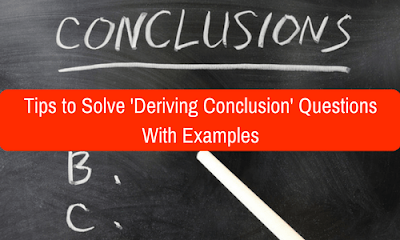Introduction:
This type of question no doubt demands your comprehension power of the given passage; it also requires your reasoning power so as to arrive at the correct conclusion out of the options given. We can learn about it through practice.


How to Make Inferences?
Aspirants must merge the clues in the given text with their prior knowledge and determine the answers to the questions that lead to conclusions about the underlying ideas.
Tips to Solve the Question Pertaining to Deriving Conclusions:
Example 1:
A study of native born residents in Newland found that two-thirds of the children developed considerable levels of nearsightedness after starting school, while their illiterate parents and grandparents, who had no opportunity for formal schooling, showed no signs of this disability.
If the above statements are true, which of the following conclusions is most strongly supported by them?
If the above statements are true, which of the following conclusions is most strongly supported by them?
Options:
(A) Only people who have the opportunity for formal schooling develop nearsightedness.
(B) The nearsightedness in the children is caused by the visual stress required by reading and other class work.
(C) Both A and B
(D) None of these.
Solution:
Although over the face of it, both the options A and B appear to be true, yet the option B is more logical as it mentions the reason also. Therefore, the correct option is (B).
Example 2:
No national productivity measures are available for underground industries that may exist but remain unreported. On the other hand, at least some industries that are run entirely by self-employed industrialists are included in national productivity measures.
If the above statements are true, which of the following conclusions is most strongly supported by them?
If the above statements are true, which of the following conclusions is most strongly supported by them?
Options:
(A) There are at least some industries run entirely by self-employed industrialists that are underground industries.
(B) No industries that are run entirely by self-employed industrialists operate underground
(C) There are at least some industries other than those run entirely by self-employed industrialists that are underground industries.
(D) There are at least some industries run entirely by self-employed industrialists that are not underground industries.
Solution:
As the paragraph discusses about the underground industries. Of the given four options, the most appropriate option seems to be (D). Therefore the correct option is (D).
Example 3
The basic thrust, of the Government's policy is to provide price incentives to farmers to make them produce more food. But is a price-incentive system, always efficient in ensuring incremental yields? Our contention is that this incentive works only in persuading farmers to shift cultivation from one crop to another depending on which crop is more profitable at) the given prices. But it would not be a sufficient condition in ensuring incremental output of all crops which is what is required.
If the above statements are true, which of the following conclusions is most strongly supported by them?
If the above statements are true, which of the following conclusions is most strongly supported by them?
Options:
(A) If you think the inference is “Definitely True”.
(B) If you think that the inference is “Probably True” although not definitely true in the light of the facts given.
(C) If the data given is inadequate i.e. from the statements given above, you cannot say whether the inference is likely to be true or likely to be false.
(D) If you think that the inference is “Probably False” although not definitely false in the light of the facts given.
Solution:
The writer is discussing in detail the Government’s policy of providing incentives to farmers to make them produce more food including the negative aspects. Here the option (A) appears to be the correct answer because the inference drawn appears to be “Definitely True”.


